Amy Burnett
My name is Amy Burnett and my ParaBadminton career has only just begun. However, my journey getting here has been a long and winding one through the ups and downs of many different sports. I just happened to stumble upon the sport while watching the 2016 Olympics. My tv was left on a channel that was broadcasting Badminton. Like many of you, I was entranced by the speed of the shuttle and the ability of the players. I was mesmerized, and felt like a kid watching a sport for the very first time although this in fact was not the first time I had seen Badminton.
Like most Americans, I was introduced to the sport in a grade school physical education class. Later, my parents bought a set and we played it, as a family, in the backyard. I remembered having so much fun playing as a kid and now watching it on tv, I was transported back to that time. I liked the feeling and wondered if this was a sport offered to para athletes. So, with a little research I found an email and contacted the Badminton World Federation. Before long, they replied and gave me the contact for USA ParaBadminton and thus my journey began. I contacted Steve Kearney, the USA ParaBadminton Director, telling him of my interests, and let him know where I would be the next few months, since I travel in an RV, part of the year but call Nashville, TN. my home. He gave me a list of where I could find Badminton clubs and people I could hit with. And thanks to the Challenged Athletes Foundation I was able to start my ParaBadminton journey.
So I set out on a trip that first stoped in Ft. Lauderdale, FL. where I took my first lesson from Dave Zarco, at Shula’s Badminton. My next stop was in Mesa, AZ at the Arizona Badminton Center with owner, Guy Chadwick. AZBC was where I gathered a couple months of learning. Currently, because I am the only player in the USA, in a wheelchair, I have no one to hit against at my height and level. So, Guy pulled his office chair onto the court and hit with me. He began playing matches with me that he continuously won. He also had me join his kid’s class. I was a helper, as he told the kids, but we knew was mostly a student. It was very useful, as the kids were a good height for me, and they didn’t mind trying to hit me with every shot. It was a great start for me.
Then, I was on the road again and I traveled over to Manhattan Beach Badminton Club in California. I hit with Dean Schoppe, for an afternoon, and I enjoyed a class with their junior team. Then he then told me about a guy in Nashville that I could hit with for the next six months. I was very excited to know that I could find Badminton in Tennessee. I started practicing with David Shaw and the Nashville Badminton Association, in the early spring. However, at that time no other wheelchair players had taken up the sport. Thus, I was challenged with hitting with, David, a man around six feet tall. I had no idea how my lessons would compare to others in chairs. I just did my best and hit with anyone willing to hit with me in hopes that any hitting was better than no hitting. For the next few months I let David train me to the best of his ability, as he had never seen ParaBadminton either, and then my moment came. Steve Kearney let me know I had become part of Team USA and he was sending me to Peru to represent our county. I was excited to hear I would be going to go to Peru, but I was super excited to know that I was named the first person in a wheelchair to the USA ParaBadminton team.
We talked about my upcoming trip to the Peru International ParaBadminton Tournament that would take place on August 2 through 6, 2017. We discussed how I would primarily be there to learn and watch the other players from my category. As this was to be my first time ever, to see wheelchair playersin person, I traveled with my rackets, pen and paper to Lima, Peru.
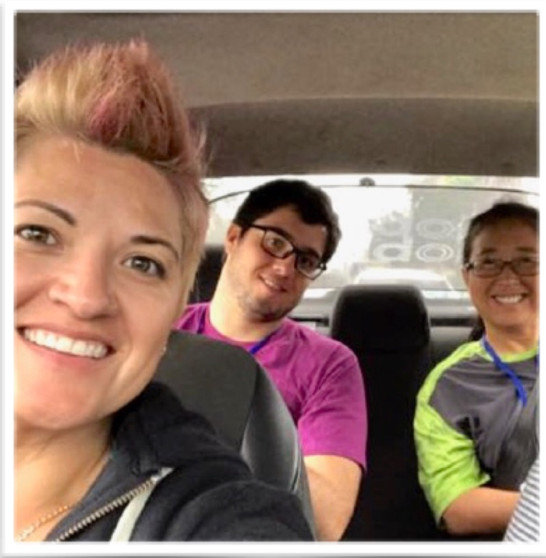
Upon my arrival, I was met by the tournaments transportation director, Salvador Diez Canseco, and team. They all wanted pictures with me and they treated me like I was already a ParaBadminton medalist. Little did they know, I was at my first tournament. A few moments later, I found myself in a cab on the way to my hotel feeling overwhelmed with emotion. I was there to represent my country and I was the only team member who was able to make the tournament. There I was at my first tournament, and I was alone, with no family or friends to cheer me on and support me. At the time, this felt like a heavy weight on my shoulders.
Upon arriving at the hotel I met Yuko Kawasaki, my coach for the tournament. We also shared a room which was quite nice as we are close in age and I really enjoyed her company. However, she was also taking a course to become an athlete classifier, therefore I didn’t get to see her much during the day other than during my matches and dinner.
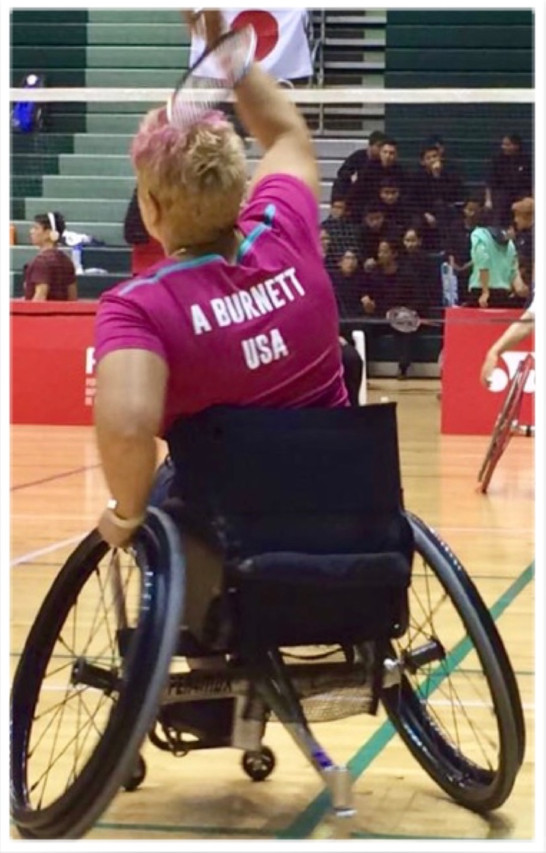
Thanks to for a great looking team USA
My first day was nothing like I had imagined, especially after the wonderful greeting from the plane. Transportation came to pick me and the other players up. It was a full size conversion van with no lift. So, day one began with me crawling onto the van and up into a seat. Not to mention the entire Japanese team was watching. This kind of transfer is not easy and I didn’t want my competition seeing my weaknesses before being across court from them. Unfortunately, there I was in all my grander for them to evaluate.
The day just continued with a bit of culture shock and then a nice call home asking my family to speak English with me. I have friends from other countries, so I’m well versed in Google Translation however, this was unexpected. Being the new kid on the block without friends yet, I was a bit out of sorts. Everyone was there with their teammates talking and I didn’t know where to begin. It seemed as if everyone was looking at me and talking to each other about me. As it turned out, that was exactly what they were doing because I am the first ever wheelchair player from the USA. Therefore, they were talking about me.
I spent the next several hours just watching many of the athletes practice with their teams. I was amazed at all of the different disabilities that I had never see before, on a competitive level. I have a background in wheelchair basketball and tennis but these sports are without standing divisions. I also found myself slightly irritated because I realized that my disability is more limiting than almost everyone, if not everyone, that was there. Thus, I knew that there was probably a flaw, of some sort, in the classification process. I later found out that there once were more wheelchair divisions but they were all combined into two. I made my way to the classification room and did my testing to determine my category. I was classed as a WH 1 player out of the 2 wheelchair categories. Then, I left the classification room and headed back towards the gym, yet to have made any friends there.
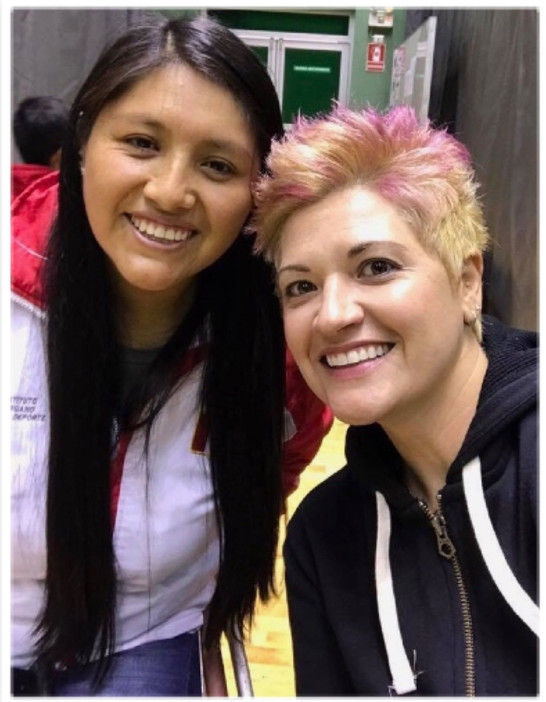
Before I left the country Mike Krajewski, the father of team USA’s youngest member Miles, sent me a text with the name and photo of a young man from the Peruvian team, Jesús Salvá Tunque. He told me this was a guy that Miles had played doubles with and that he would be a great contact for me at the tournament. Mike was correct and unbeknown to him, he saved my first day. As I was going towards the gym, I saw this young man walking by and into the gym. I followed him in and found him talking to a girl in a wheelchair. I went over and introduced myself to him. He was very nice and immediately hugged me and kissed my cheek. That is a traditional greeting in Peru. This made me feel at ease. Then, he introduced me to his friend Pilar Jauregui Cancino. She spoke English and quickly became my favorite athlete, in the wheelchair division, there.
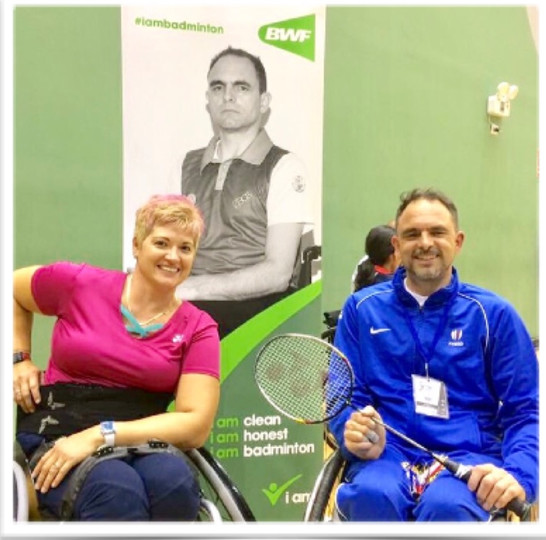
Over the course of the next few days, I made many new friends. Sitting with the Brazilian team during lunch and jumping from one group to the next, speaking with everyone primarily about badminton, while watching matches. Then, I received another text from Mike telling me to introduce myself to Richard Perot, from the French team. As, he had not steered me wrong previously, I trusted his message. I went right over to Richard and started a conversation about Mike and Miles. One thing led to another and I found myself deep in conversation about everything from what type wheelchairsare the best for the sport, and the reasons why I will need to learn specific strokes. He even discussed a winning strategy. He taught me so much, especially as he is also a WH1 player.
Meeting new friends was a great part of my tournament in Peru, but not the reason I had come to be there. In preparation for all of my matches I followed the same cadence. I put on my headphones and listened to my go-to warm up song, Sia’s “Unstoppable”. While stretching and warming up I like to listened to the words of this particular song. She says, “I put my armor on to show you how strong I am. I put my armor on to show you I’m unstoppable.” This is how I felt putting on the USA team uniform.
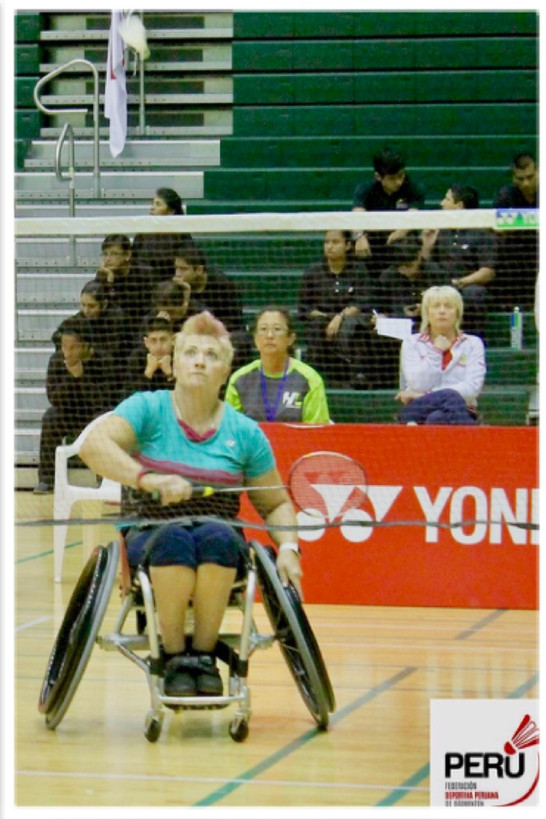
I was aware that my first badminton match would literally be the first time I ever hit against a trained badminton para athlete. However, I knew that I came from a county of the highest standards and no matter what I was going to give it all I had to win. Although I wanted to win more than anything, as most athletes do, I had only two rules for myself going into this competition. 1. Represent my country, at all times, in a positive and respectable manner and 2. Under no circumstances could anyone beat me with a score 21-0 in any set of any match, included doubles.
I was able to accomplish both of my goals, and even though I did not win any of my singles matches, my first ever set score was 21-15. Yuko and I were both in agreement that if I had played her on the second day I would have beaten her. Still, as this was my debut, you can imagine my feelings during the match. As all of the para athletes, that were there watching me play, surveyed my abilities and judged what the USA had to offer, my nerves got the best of me in the second set. That day a very happy Brazilian girl left the court, with her win, and I, an extremely proud American girl left with her head held high. I had trained for this match in what seemed like the dark and I had just found the light.
I met with Ronald Stalin Miranda Montero, from Peru, my mixed doubles partner later that day. As he was also a WH1 player, I knew that our prospects of winning matches would prove to be more than just difficult because the ultimate paring in all doubles is WH1-WH2. However, when you’re the newest kid on the block, at your first tournament, you smileand say “yes” and “thank you” when you hope to find a partner. We had a great time working on his English and my Spanish, badminton terminology, during our matches. Even though we struggled, we did not go down without a fight, despite the level of play between us and our competitors.
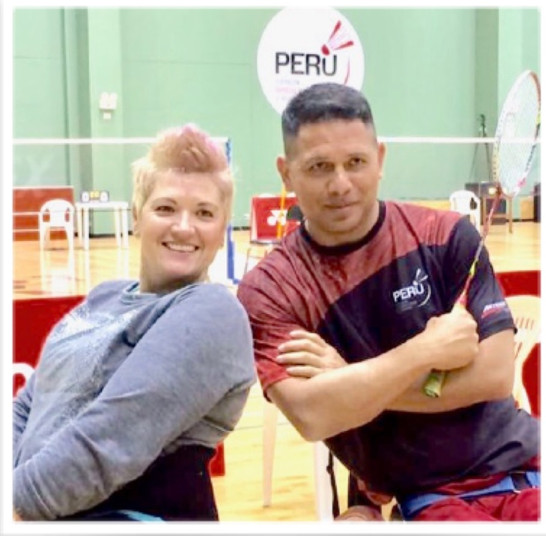
Then, I met Liliya Prokofeva, from Russia. She had sent me a message on Facebook asking if I would be her doubles partner. I responded yes and was super excited to meet her in person. We joked about Trump and Putin’s highly publicized relationship together, along with many others at the tournament, when they found out USA and Russia were partnering. Nonetheless, when we rolled onto the court everything became serious. This was a tuff partnership as her English was very sparse and my Russian is only good when typing it into a translator, which is hard to do during a match. As she did not have a translator or coach with her we spoke a lot using hand jesters. My coach Yuko will remember that I made one loud cat noise after Liliya had been yelling at me. Despite all of our barriers we managed to win our first match 21-2, 21-4. We fell short in our second match, but ultimately tied with those ladies in the end. Winning 21-6, 21-7 in the third match, then falling short in the forth to the over all winners. The winners also won all of the women’s divisions including WS WH1, WS WH2 and WD WH1-WH2.
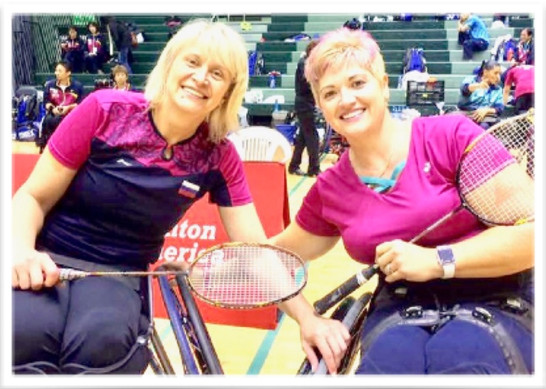

In the end, I managed to earn a bronze medal at my first tournament. My feelings of USA pride were met head on when I was asked to walk, representing the USA, at the closing ceremony. I had no idea what they meant by closing ceremony but I answered yes, as I was the only American there. There were many athletes in attendance. Some of the athletes were the only people there from their home county. Therefore, I noticed that the room became quiet when the name and country were called for the athletes that were there alone, like myself. As I stood at the back of the line with my country’s sign I was listening to the crowd cheer loudly for countries with many athletes in attendance. I wished that my friends and family could have been there to cheer and share the special occasion with me when my name and country were called out. Since my coach had caught an earlier flight, I was all alone and I braced myself for the impact of crickets chirping. I heard, “And representing the United States ofAmerica, Amy Burnett.” The room was so loud with the voices of my new friends and ParaBadminton family. I could not believe that in just a few short days I had made enough friends to fill an entire gym, so loudly. I was so overwhelmed with feelings of gratitude.
As, I rolled into the closing ceremony, I sat by my doubles partner, Liliya. We smiled at each other and watched as children danced for us to native music, that told an amazing story of the progression of the Peruvian people. Then, adult dancer came out and danced. It was beautiful and a moment I will never forget. After the music and dancers finished, all of the country representatives went back and joined everyone else. Then, the presentation of the medals began. I enjoyed getting to see everyone with their medals and still could not believe that I had earned one myself.
After the closing ceremony and medal presentations everyone went around exchanging gifts with each other from all the different countries and taking photographs. So many people, including the line judges, bus drivers, coaches, referees, players and officials asked to have their picture taken with me. My tournament ended as it had begun; the people treated me like a medalist in ParaBadminton and now I had become one.
Next, its back to my training in Arizona with Guy and then, to the first ever ParaBadminton International Tournament in the USA. There are so many firsts this year for me to count. With that being said, my being the first wheelchair player to represent the United States in ParaBadminton is something I will never forget. Lima, Peru will alway hold a special place in my heart, along with that single bronze medal.
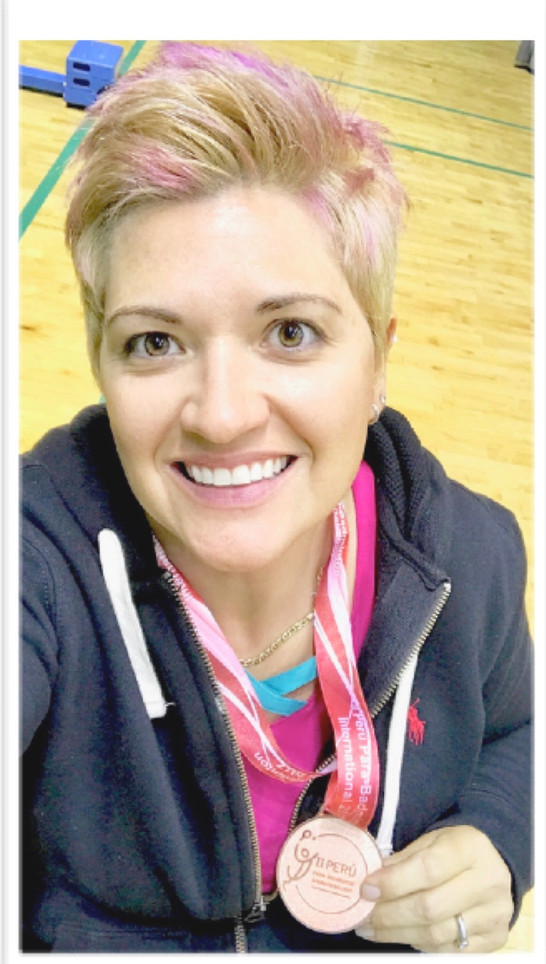
Amy Burnett, Team USA ParaBadminton, pictured with her WD WH 1 – WH 2 bronze medal from Lima, Peru.
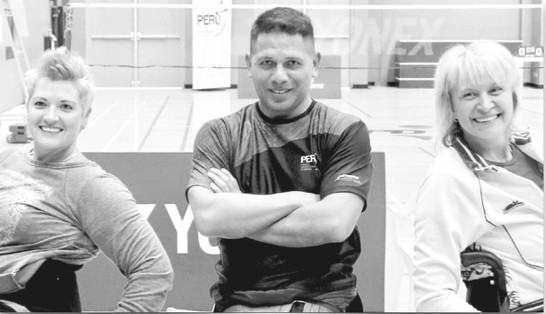
Pictured above with my women’s and mixed doubles partners Ronald Stalin Miranda Montero, of Peru, and Liliya Prokofeva, of Russia.
